THE PAINT BRUSH -- PART TWO
Opacity
Opacity determines transparency of the paint. A setting of 1 makes the paint almost completely transparent. A setting of 100 makes the paint opaque. The following exercise illustrates the opacity setting.
- Open a new file.
File > New
Settings:
Width: 200 Pixels
Height: 100 Pixels
Resolution: 72 Pixels/inch
Background Color: White
Image Type: 16.7 Million Colors
- Set your ruler to display in pixels.
File > Preferences > General Program Preferences > Rulers and Units
Ruler Frame Settings:
Display Units: Pixels
- Make sure the ruler is turned on.
View > Rulers

- Select the Text tool
 .
. - Place the pointer at 50 pixels across and 50 pixels down.
- Click on the image to open the Text Entry dialog box. Set the tool options.
Settings:
Name: Arial
Size: 10
Script: Western
Create As: Floating
Antialias: Yes
Text Color: Black (Click on the color box to select a color.)
Kerning: 0
Leading: 0
Auto Kern: Yes
Center
Enter Text Here: Opacity
- Remove the Selection.
Selections > Select None
- Your image should look like the one shown here.

- Select the Paint Brush tool. Set the tool options.
Paint Brush Tab Settings:
Paint Brush Type: Normal
Shape: Square
Size: 50
Hardness: 100
Opacity: 40
Step: 100
Density: 100
Paint Brush Options
Paper Texture: None
Built Up Brush: Yes
Cursor and Tablets
Use Precise Cursor: Yes
Show Brush Outlines: Yes
- Set your foreground color to red.
Settings:
Red: 255
Green: 0
Blue: 0
- Click once, right on top of the word "opacity." Your image should look like the one shown here.
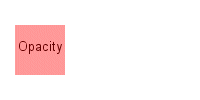
- Select the Text tool.
- Place the pointer at 150 pixels across and 50 pixels down.
- Click on the image to open the Text Entry dialog box. You want to place the word "opacity" on your image again. You do not need to adjust your settings. Click on OK to close the Text Entry dialog box. Your image should now look like the one shown here.
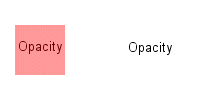
- Remove the selection.
Selection > Selection None
- Select the Paint Brush tool. Reset the opacity of the Paint Brush tool. Do not change any of the other settings.
Settings:
Opacity: 100
- Click once, right on top of your second entry of the word "opacity."
- Your image should now look like the one shown here. Note the effect of changing the opacity setting.

- Close the image. Save your image if you like.
File> Close
Step
Step controls when paint hits the canvas as you drag the brush across the canvas. The following exercise illustrates the step setting.
- Open a new file
File > New
Settings:
Width: 200 Pixels
Height: 200 Pixels
Resolution: 72 Pixels/inch
Background Color: White
Image Type: 16.7 Million Colors
- Select the Paint Brush tool. Set the tool options.
Paint Brush Tab Settings:
Paint Brush Type: Normal
Shape: Round
Size: 50
Hardness: 100
Opacity: 60
Step: 50
Density: 100
Paint Brush Options
Paper Texture: None
Built Up Brush: Yes
- Set your foreground color to red.
Settings:
Red: 255
Green: 0
Blue: 0
- Drag your pointer from left to right across the top of your image. Your image should look like the one shown here.
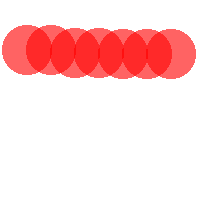
- Reset the step of the Paint Brush tool. Do not change any of the other settings.
Settings:
Step: 100
- Drag your pointer from left to right across the bottom of your image.
- Your image should look like the one shown here. Note the effect of changing the step setting.

- Close the image. Save your image if you like.
File> Close
Density
The Density setting controls the concentration of the paint when the brush hits the canvas. A density of 100 produces a high concentration of paint. A density of 1 produces speckles of paint. The following exercise illustrates the density setting.
- Open a new file
File > New
Settings:
Width: 200 Pixels
Height: 100 Pixels
Resolution: 72 Pixels/inch
Background Color: White
Image Type: 16.7 Million Colors
- Select the Paint Brush tool. Set the tool options.
Paint Brush Tab Settings:
Paint Brush Type: Normal
Shape: Square
Size: 50
Hardness: 100
Opacity: 100
Step: 100
Density: 20
Paint Brush Options:
Paper Texture: None
Built Up Brush: Yes
- Set your foreground color to red.
Settings:
Red: 255
Green: 0
Blue: 0
- Click once on the left side of the image. Your image should look like the one shown here.
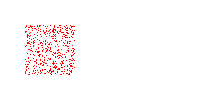
- Reset the density of the Paint Brush tool. Do not change any of the other settings.
Settings:
Density: 100
- Click once on the right side of your image.
- Your image should look like the one shown here. Note the effect of changing the density setting.
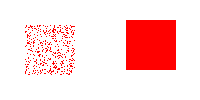
- Close the image. Save your image if you like.
File> Close
Paper Texture
With Paint Shop Pro, you can paint using a variety of paper textures. Use paper texture to change the look or motif of the color you apply. Paint Shop Pro provides a long list of paper textures. The following exercise illustrates two of them. You should experiment with all of them.
- Open a new file
File > New
Settings:
Width: 200 Pixels
Height: 100 Pixels
Resolution: 72 Pixels/inch
Background Color: White
Image Type: 16.7 Million Colors
- Select the Paint Brush tool. Set the tool options.
Paint Brush Tab Settings:
Paint Brush Type: Normal
Shape: Square
Size: 100
Hardness: 100
Opacity: 100
Step: 100
Density: 100
Paint Brush Options:
Paper Texture: Squares
Built Up Brush: Yes
- Set your foreground color to red.
Settings:
Red: 255
Green: 0
Blue: 0
- Click once on the left side of the image. Your image should look like the one shown here.
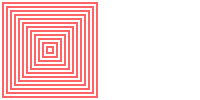
- Reset the paper texture of the Paint Brush tool. Do not change any of the other settings.
Settings:
Paper Texture: Polka Dot
- Click once on the right side of your image.
- Your image should look like the one shown here.
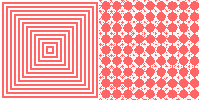
- Close the image. Save your image if you like.
File> Close
Custom Brushes
In addition to the paintbrush tips listed in the Shape field, Paint Shop Pro provides several custom brushes. And, you can create your own custom brush. The following exercise illustrates how to use a custom brush.
- Open a new file
File > New
Settings:
Width: 200 Pixels
Height: 100 Pixels
Resolution: 72 Pixels/inch
Background Color: White
Image Type: 16.7 Million Colors
- Select the Paint Brush tool. If it is not already open, open the Tool Options dialog box.
- Click on the Brush Types icon. A drop-down menu will appear. Select Custom.

- The Custom Brush dialog box will open. Select the Star and click on OK.
- Set the remaining tool options.
Paint Brush Tab Settings:
Opacity: 100
Step: 100
Paint Brush Options
Paper Texture: None
Built Up Brush: Yes
- Set your foreground color to blue.
Settings:
Red: 0
Green: 0
Blue: 255
- Set your background color to red.
Settings:
Red: 255
Green: 0
Blue: 0
- Create an image like the one shown below. Left-click to paint the blue stars. Right-click to paint the red star.

- Close the image. Save your file if you like.
File> Close
| Table of Contents |

